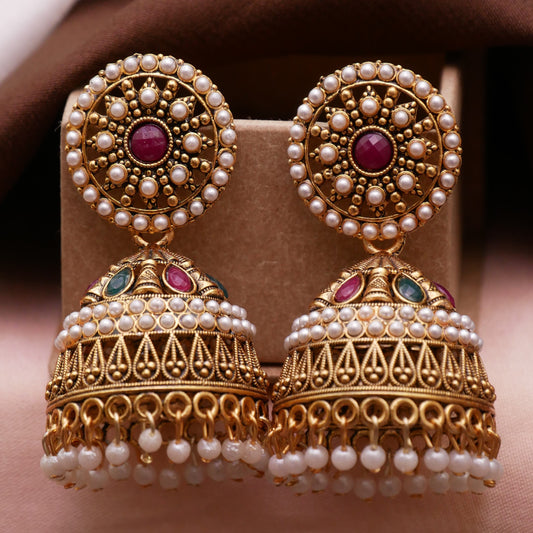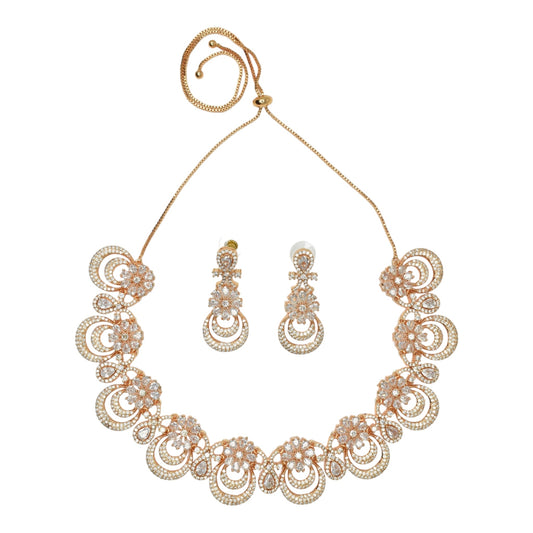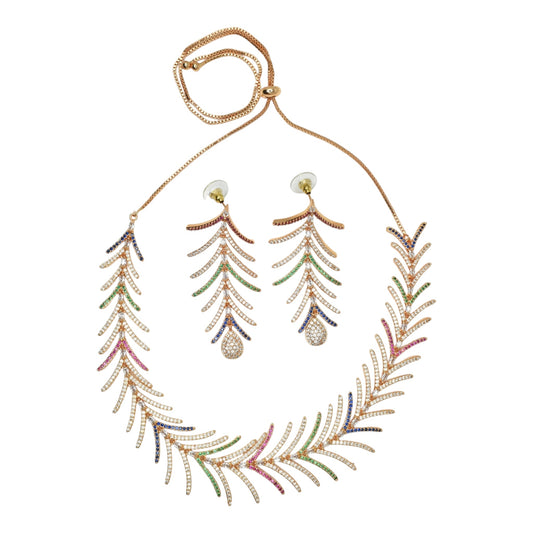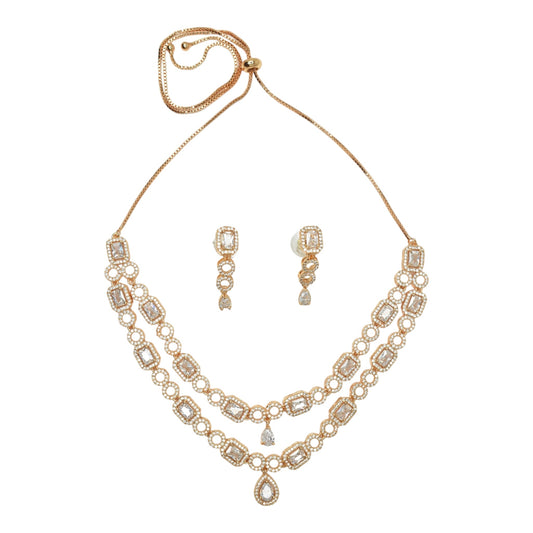राजस्थानी आभूषण

भारत में लगभग सभी संस्कृतियों में आभूषण हमेशा से ही दुल्हन के परिधान का एक महत्वपूर्ण हिस्सा रहे हैं। लेकिन राजस्थान में आभूषण अपने आप में एक परिधान की तरह हैं। राजस्थानी आभूषण सेट राज्य की महिलाओं के सदियों पुराने रीति-रिवाजों और पारंपरिक पहनावे की अभिव्यक्ति है। इसकी पुरानी यादें और आकर्षण वाकई बेमिसाल हैं। आइए एक नज़र डालते हैं उन अलग-अलग तत्वों पर जो एक सच्चे राजपूती आभूषण सेट को बनाते हैं।
राजस्थानी आभूषण के प्रकार
1. बोरला / मांग टीका

राजस्थान में मांग टीका बोरला के नाम से जाना जाता है। आम बोरला से अलग, यह गोलाकार होता है और सोने से बना होता है। परंपरागत रूप से राजस्थानी बोरला कुंदन, मोती और मीनाकारी के काम से जड़ा होता है। आजकल दुल्हनें इसे दो तरफ़ की चेन के साथ पहनती हैं जिसे शीशफूल कहते हैं।
यह राजस्थानी टीका राजस्थानी आभूषण सेटों और विशिष्ट, राजपूती आभूषण सेटों दोनों के बीच एक विशिष्ट विशेषता बन जाता है।
2. नाथ

नथ, जिसे नाक की अंगूठी के रूप में भी जाना जाता है, भारतीय संस्कृति का एक अभिन्न अंग रहा है, खासकर राजस्थान में। विभिन्न आकार, शैलियों और रंगों में उपलब्ध, इसे बाएं नथुने पर पहना जाता है और बाएं कान में सोने की चेन से जोड़ा जाता है। राज्य में नथ को विवाहित होने का प्रतीक माना जाता है।
इस बीच, इस गाइड को पढ़ने पर विचार करें जिसमें नाक की अंगूठी के विभिन्न डिजाइनों के बारे में बताया गया है, जिन्हें आप अपने खास दिन के लिए चुन सकते हैं।
3. कंठी

कंठी राजस्थानी आभूषण सेट के सबसे ज़रूरी तत्वों में से एक है। यह राज्य का एक पारंपरिक चोकर नेकपीस है जो आमतौर पर एडजस्टेबल धागे के साथ आता है ताकि यह किसी भी आकार के गले में फिट हो सके। इसके अलावा, राजस्थानी महिलाएँ एक नेकपीस भी पहनती हैं जो नाभि तक लंबा होता है जिसे रानी हार के नाम से जाना जाता है।
यदि गले में पहने जाने वाले वस्त्रों के क्रम में रखा जाए, तो यह सेट तिमनिया या आड़ से शुरू होता है, फिर कंठी और फिर रानी हार या महारानी हार तक पहुंचता है - जो अंतिम हार के आकार पर निर्भर करता है।
4. तिमानिया / आद

तिमनिया एक बहुत ही प्रसिद्ध राजपूती गले का आभूषण है जिसे राजस्थानी भाषा में आड़ के नाम से भी जाना जाता है। यह चौकोर या आयताकार आकार का चोकर होता है जिसे आमतौर पर दूल्हे के परिवार द्वारा दुल्हन को उपहार में दिया जाता है। यह देखने में बहुत ही शानदार लगता है और दुल्हन की खूबसूरती को बढ़ाता है। परंपरागत रूप से इसे सोने और कुंदन से बनाया जाता था लेकिन आजकल हीरे से बना तिमनिया दुल्हनों के बीच बहुत लोकप्रिय है।
5. गजरा और चूड़ियाँ

राजस्थानी महिलाओं द्वारा पहनी जाने वाली दो चूड़ियों का एक बहुत ही खास सेट, बंगड़ी में एक मोटी परत और छोटे सोने के उभार होते हैं। परंपरागत रूप से, बंगड़ी सोने और प्लास्टिक से बनाई जाती थी, लेकिन अब इसके कई रूप उपलब्ध हैं।
आधुनिक शैली की बंगड़ी सोने और हीरे से बनी होती हैं और इन्हें पचेली चूड़ियाँ कहा जाता है। अविवाहित राजस्थानी महिलाएँ आमतौर पर ये चूड़ियाँ नहीं पहनती हैं क्योंकि ये दुल्हन को उसकी शादी में उपहार में दी जाती हैं।
6. हाथ फूल

हाथ फूल एक आभूषण है जो हथेली के पिछले हिस्से और कलाई पर पहना जाता है। यह एक ऐसा आभूषण है जिसमें एक या कई नाज़ुक चेन होती हैं जो एक समायोज्य अंगूठी के साथ एक चूड़ी या कंगन से जुड़ी होती हैं। रॉयल हाथ फूल कीमती धातुओं और पत्थरों जैसे सोने, मीनाकारी, कुंदन और कभी-कभी जड़ाऊ से बने होते हैं।
7. कमरबंद

राजस्थानी आभूषण सेट का एक और बहुत महत्वपूर्ण हिस्सा कमरबंद है, जो कमर की चेन है। इसे राजस्थान में करधनी या तगड़ी के नाम से जाना जाता है और आमतौर पर इसे सोने की पोल्की या कुंदन से बनाया जाता है। इस आभूषण की सबसे अच्छी बात यह है कि आप इसे साड़ी, लहंगे या यहां तक कि एथनिक गाउन के साथ भी पहन सकती हैं।
8. पायल

टखने के आसपास पहनी जाने वाली पायल को पायल या पाजेब के नाम से भी जाना जाता है। यह दुल्हन के आभूषण सेट का एक अनिवार्य हिस्सा है। राजस्थानी महिलाएँ सबसे भारी पायल या कड़ा पहनती हैं जो आमतौर पर चांदी से बना होता है। चूँकि पैरों में सोना पहनना अशुभ माना जाता है, इसलिए आधुनिक राजपूती दुल्हनें सोने की परत चढ़ी पायल या मीनाकारी या कुंदन के काम वाली पायल पहनना पसंद करती हैं।
9. बाजूबंध

बाजूबंद या बाजूबंद एक तरह का कंगन होता है जिसे किसी एक हाथ के ऊपरी हिस्से में पहना जाता है। शादी के लिए महत्वपूर्ण आभूषण होने के अलावा, यह एक महत्वपूर्ण फैशन आभूषण भी है। नाज़ुक से लेकर मज़बूत तक, इन दिनों सोने और चांदी जैसी कीमती धातुओं से बने कई तरह केबाजूबंध उपलब्ध हैं।
10. पैर की अंगूठियां

जब हम राजस्थानी आभूषण सेट की बात करते हैं, तो इसे बिना पैर की अंगूठियों के पूरा नहीं माना जा सकता। बिछुवा के नाम से भी जाना जाने वाला यह बिछुवा दुल्हन को उसके माता-पिता द्वारा उपहार में दिया जाता है और दूसरे पैर की अंगुली में पहना जाता है। पारंपरिक राजस्थानी बिछुवा सोने की परत चढ़ाकर फूलों के डिज़ाइन में बनाई जाती है। यह भारतीय परिधानों पर बहुत खूबसूरत लगती है।
11. रानी हार

रानी हार और महारानी हार के प्रकार राजस्थानी आभूषण सेट के लिए सबसे लंबे गले के टुकड़े हैं और इसे एक स्पष्ट, राजसी एहसास प्रदान करते हैं। रानी हार हार कंधों से नाभि तक फैली हुई है, जिसके बीच में एक बड़ा आभूषण है। चूंकि यह दुल्हन के शरीर के सबसे बड़े हिस्से को कवर करता है, इसलिए ये आभूषण नाजुक, जड़ाऊ आभूषण या पोल्की और कुंदन संग्रह से भारी आभूषण हो सकते हैं।
12. लाख की चूड़ियाँ

एक पारंपरिक आभूषण जो प्रामाणिक राजस्थानी आभूषण सेट को पूरा करता है, लाख की चूड़ियाँ राजस्थानी दुल्हन के लिए विवाह के मुख्य संकेतों में से एक हैं। हालाँकि ये चूड़ियाँ लाख और हाथीदांत से प्लास्टिक की चूड़ियों में बदल गई हैं, फिर भी ये दुल्हन के समग्र रूप में एक अलग स्पर्श जोड़ती हैं।
हालांकि मूल रूप से चूड़ियां दुल्हन की बांह से लेकर कोहनी तक ढकी होती थीं, लेकिन अब अधिकांश महिलाएं परंपरा के कारण कुछ चूड़ियां पहनना पसंद करती हैं।
13. माथा पट्टी - शिशफुल

माथापट्टी महिलाओं द्वारा पहना जाने वाला एक पारंपरिक राजस्थानी सिर का आभूषण है। यह माथे पर, भौंहों के ठीक ऊपर पहना जाने वाला एक अलंकृत आभूषण है। माथापट्टी आमतौर पर सोने या चांदी से बनाई जाती है और रत्नों और विस्तृत रूपांकनों से अलंकृत होती है। इन्हें अक्सर जोड़े में पहना जाता है, जिसमें माथे के दोनों ओर एक-एक माथापट्टी होती है। माथापट्टी राजस्थानी परंपरा में एक महिला की विवाहित स्थिति का प्रतीक है, और अक्सर एक महिला को उसके पति द्वारा उपहार के रूप में दिया जाता है। इन्हें अक्सर शादियों और अन्य विशेष अवसरों पर पहना जाता है, और ये राजस्थानी दुल्हन की पोशाक का एक प्रमुख पहलू हैं।
माथापट्टी, जिसे राजस्थान और गुजरात में मांग टीका के नाम से भी जाना जाता है, महिलाओं द्वारा पहना जाने वाला एक पारंपरिक भारतीय सिर का आभूषण है। यह माथे का एक आभूषण है जो एक चेन से बना होता है जिसमें एक पेंडेंट होता है जो माथे के बीच में लटकता है। माथापट्टी आमतौर पर सोने या चांदी से बनी होती है और हीरे या मोती जैसे आभूषणों से सजी होती है। इन्हें आमतौर पर शादियों और अन्य बड़े अवसरों पर पहना जाता है, और भारतीय संस्कृति में इन्हें महिला की वैवाहिक स्थिति के प्रतीक के रूप में देखा जाता है। राजस्थानी और गुजराती संस्कृति में, माथापट्टी एक महिला की दुल्हन की पोशाक का एक महत्वपूर्ण तत्व है।
माथापट्टी महिलाओं द्वारा इस्तेमाल किया जाने वाला पारंपरिक भारतीय सिर का आभूषण है। यह भौंहों के ठीक ऊपर पहना जाने वाला एक सजावटी टुकड़ा है। माथापट्टी आमतौर पर सोने या चांदी से बनी होती है और रत्नों और उत्तम रूपांकनों से सजी होती है। उन्हें एक महिला की वैवाहिक स्थिति के प्रतीक के रूप में पहना जाता है और अक्सर उसके पति द्वारा उपहार के रूप में दिया जाता है। माथापट्टी एक पारंपरिक भारतीय दुल्हन का परिधान है जिसे अक्सर शादियों और अन्य विशेष अवसरों पर पहना जाता है। माथापट्टी, जिसे राजस्थानी संस्कृति में "मांग टीका" के रूप में भी जाना जाता है, आमतौर पर साड़ी या लहंगा चोली के साथ पहनी जाती है।
ये कुछ ज़रूरी तत्व हैं जो राजस्थानी आभूषण सेट बनाते हैं। इनमें से ज़्यादातर का धार्मिक अर्थ होता है और इन्हें पवित्र माना जाता है। ये इतने शाही और आकर्षक होते हैं कि आप अपनी नज़रें नहीं हटा पाएँगे।

इशिता x मीरा ज्वेलरी
इंस्टाग्राम पर इशिता रानी सा की Istate सीरीज़ के तहत उनके द्वारा चुने गए आभूषण, जिनमें हमारे द्वारा डिज़ाइन किए गए सिग्नेचर पीस शामिल हैं। ( इंस्टाग्राम पर इशिता के साथ मीरा ज्वेलरी )
राजस्थानी आभूषण संग्रह
-

राजस्थानी आद
पारंपरिक राजस्थानी आभूषण आपके अंदर की राजपूती आग को जगाएंगे।
सबसे ज्यादा पसंद किया गया ❤
हमारे सबसे पसंदीदा और सबसे ज़्यादा बिकने वाले आभूषणों को खोजें जिन्होंने दिलों पर कब्ज़ा कर लिया है और लोगों का ध्यान अपनी ओर आकर्षित किया है
-
बिक्री
-
बिक्री
-
बिक्री

















